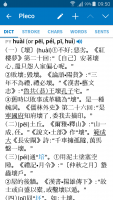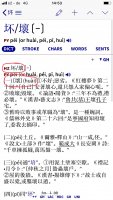Yiliya said:
Here's what mistakes in ABC I've found so far:
The following traditional variants are never used at all in ABC:
(what's used/what should be used when appropriate)
游/遊
周/週
回/迴
欲/慾
向/嚮
團/糰
(these two should be used at all times)
净/淨
羡/羨
Some more corrections:
惡/噁 (噁心 should at least be given as a variant of 惡心, this is the modern TC standard, the IMEs nowadays use 噁心, I suggest you include the word as 噁/惡心)
熏/薰 (利欲熏心 should be 利慾薰心, however ABC doesn't give any traditional variant at all, this is curious because it also gives 薰心 as a separate entry but ONLY in traditional)
注/註 (注音 is erroneously 註音 for some inexplicable reason)
There's bound to be more. I'm sorry, I'm not really using Pleco that much.
Absolutely right. I bet these are the simplified: 游, 周, 回, 欲, 向, 團, 净, 羡, 惡, 熏, 注.
Some more: 面包/麵包, 前后/前後.
注 is in 注音, and 註 as in 註冊 (the simplied is 注冊).
淨, use water to clean something, so the water part.
same as 沖, use water to flush, so the water part.
also 洗, use water to wash, so the water part.
減 is also in the water part (no idea why it is related to water), two dots is the simplified.
BUT, 凉 must be in two dots (ice part). three dots is wrong. As in 冰凉. Any one saw 冰 written in water part? There was a short story: 誤把馮京作馬凉. Explain: In the ancient time, a man called 馮京 went to take the Imperial Exam (科舉). He got the champion and went to the king's palace for the inauguration. As the king would like to call 馮京, but he called 馬凉 instead. Of course, no body answered the king. The king called again and again, and some time passed, the king looked at the name list again and apologized. He said that the name was 馮京, not 馬凉. The king said he mistakenly moved the two dots from 馮 to 京 and called 馬凉.
The font manufacturers never have the correct 凉 created. Too bad!!!



